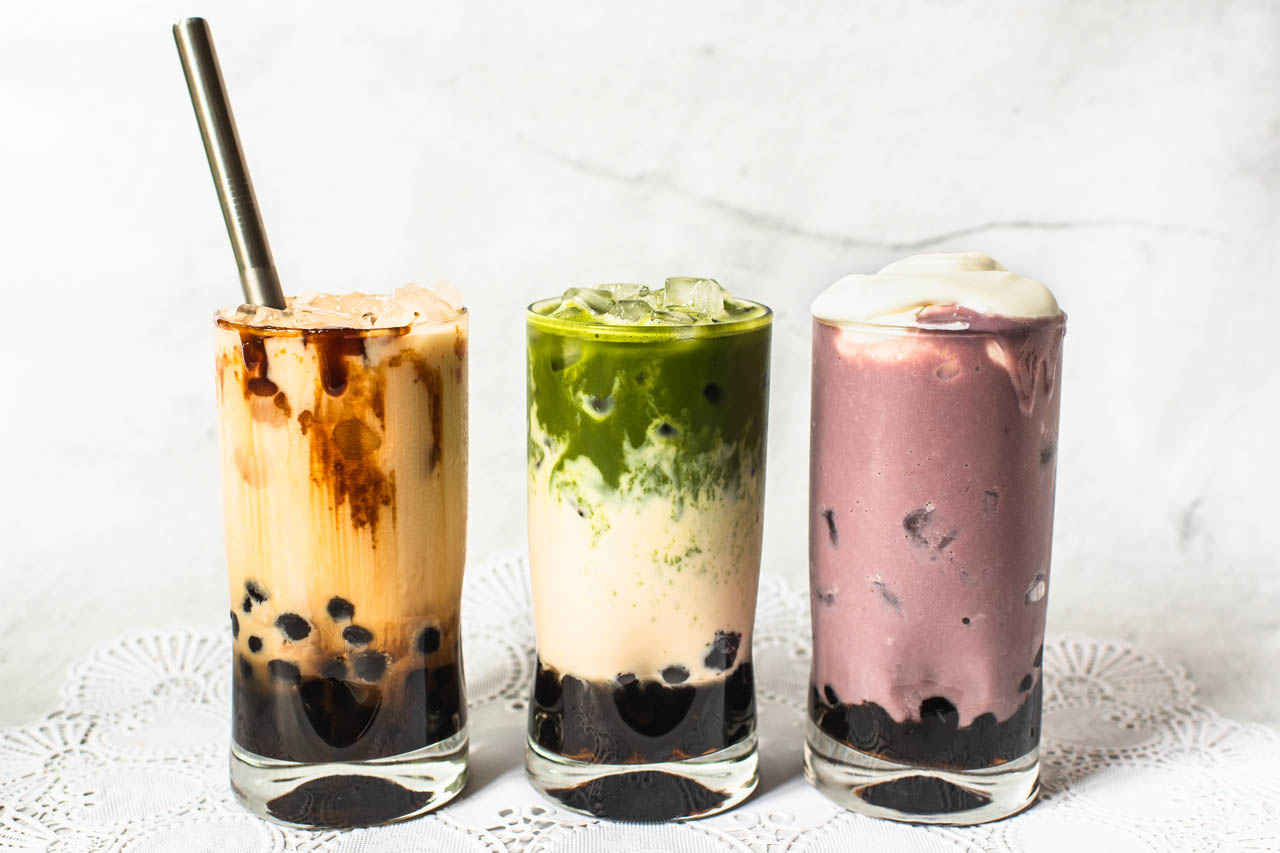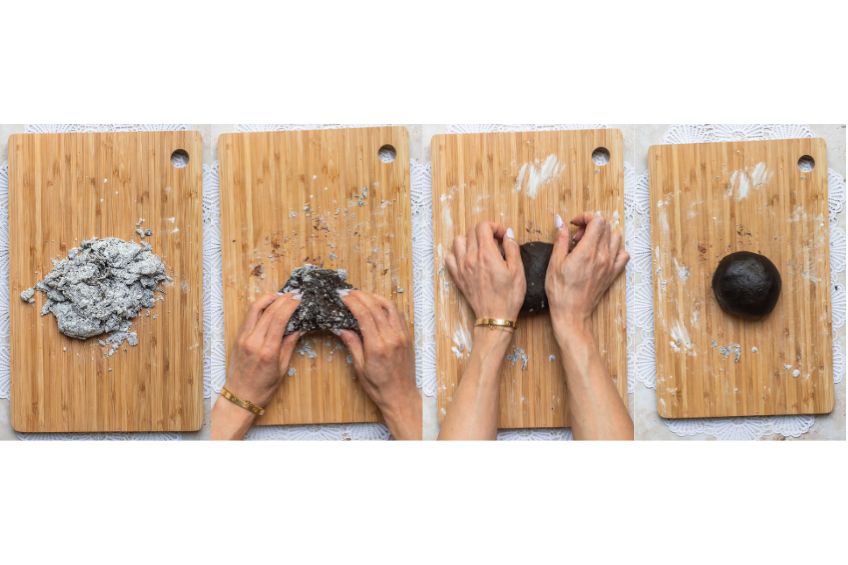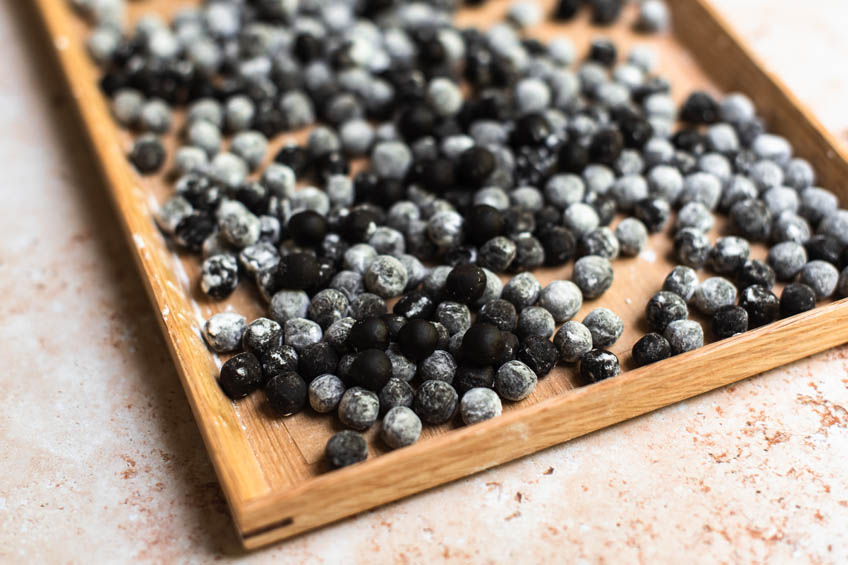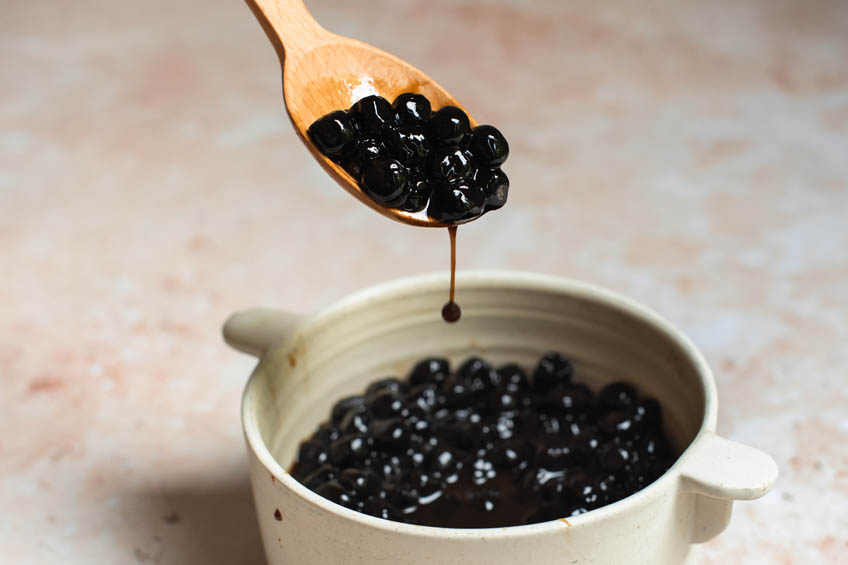
Bubble Tea is a popular drink that originated in Taiwan in the 1980s. It is also known as Boba (波霸 / bōbà) or Pearl Milk Tea (珍珠奶茶 / zhēnzhū nǎichá). The original bubble tea is made of black tea and milk (shaken) with chewy tapioca pearls. Once the popularity of bubble tea exploded — first in East Asia and continuing to sensational proportions worldwide — many, many delicious variations of the drink were spawned.
This recipe shows you how to make classic brown sugar tapioca pearls or “boba” (which can refer to both the tapioca pearls themselves or the drink) — my favourite by far. The ingredients and recipe are simple but there is one crucial first step you must follow closely and that is cooking a bit of the tapioca starch until a gelatinized “starter dough” forms, before adding the remaining tapioca starch. Otherwise, the dough will not be pliable or worst, the starch does not absorb properly and turns into an oobleck, a non-Newtonian fluid that is neither solid nor liquid (think silly putty). Follow this recipe for boba success! Making your own boba is a lot cheaper than buying at boba shops and homemade pearls contain no preservatives, artificial flavours or colours which are common in commercially sold boba including cook-at-home boba. I also think homemade tastes better.
Serve cooked tapioca pearls (boba) in one of my suggested ways or follow your fancy — there are way too many delicious options and combinations to include here. Browse your favourite bubble tea shop menu for inspiration!
Note 1: Tapioca starch (aka Tapioca flour) is grounded from cassava, a root vegetable, which makes it naturally gluten-free.
Note 2: Black sugar (aka Okinawa sugar) is made in Okinawa, Japan. It is well known in East Asian countries and is a touted ingredient to use in desserts and drinks like bubble tea, either in the tapioca pearls themselves or the sugar syrup soak. Since it is minimally refined, black sugar retains minerals like iron and magnesium, and has a complex and robust flavour with caramel notes and hint of smokiness. It is different from brown sugars which are typically refined white sugar with different amounts of molasses added to create “light” to “dark brown” sugars. Black sugar can be purchased at well-stocked East Asian grocery stores and online. If you can get your hands on some, definitely level up your homemade boba game with it!
ingredients
For brown sugar tapioca pearls (makes 1¼ cup uncooked pearls for 6 drinks)
For brown sugar syrup (makes about ½ cup – enough for soaking cooked tapioca pearls and for garnishing drinks. Make ½ portion if not using syrup for garnish)
For serving
Other ideas for serving
directions

Make the tapioca pearls (boba): Measure tapioca starch into a small bowl and set aside.
Place dark brown sugar, cocoa powder (if using), water and 2 tablespoons taken from the measured amount of tapioca starch into a medium-sized pot. Cook over medium heat while stirring constantly with a spatula. Bring mixture to a boil until sugar and tapioca starch are fully dissolved and keep cooking until mixture becomes gelatinized.
Tip: It is crucial that the mixture has gelatinized into a thick and goopy mass before moving on or else the dough will not have the proper texture. Once lumps start to thicken and form, it happens quickly and will be very obvious.

As soon as mixture has gelatinized, immediately remove from heat and add remaining tapioca starch in a steady stream (rather than all at once) while mixing vigorously with a spatula until a shaggy dough begins to form. It’s normal to have a lot of dry tapioca starch all over the dough at this point. Transfer shaggy dough onto clean surface for kneading. While the dough is still warm, quickly knead until a smooth and pliable dough forms. If the dough feels too sticky to handle, dust lightly with tapioca starch and continue kneading. If the dough feels too dry or is cracking, moisten hands with water and continue kneading for a while to work the extra moisture into the dough. The formed dough should be uniformly soft, pliable and not really tacky to touch — as joyous as fresh, soft playdoh.
Tip: If your dough is completely crumbling rather than kneading into a dough, there could be two reasons — there was not enough water or it did not gelatinize before the remaining starch was added. Start over. Make sure mixture is thick and goopy per instructions above and you don’t evaporate too much water in the boiling step (work quickly). If your dough has turned into an oobleck, where it oozes slowly through your fingers and does not hold its shape, your tapioca starch was added too quickly and did not properly absorb, start over. No amount of added tapioca starch can save it once it has become an oobleck. Again, make sure starter dough is gelanized, and mix quickly while streaming the remaining starch into the mixture.

Measure the circumference of your bubble tea straw (they do vary a bit). The size of your tapioca pearls must be small enough to be sucked through the straw. For example, our straws measure ⅜-inch in circumference.
Roll dough to ¼-inch thickness. Cut into ¼-inch strips. Keep dough covered to prevent drying out. Take one strip and cut into small pieces that will roll into pearls just smaller than the circumference of your straw.
Tip: If dough crumbles while rolling, there was not enough water in the dough but you can remedy this by pushing the dough firmly into a lump with wet fingertips and continue rolling. You may also need to dampen palms. If dough feels too sticky to cut or roll, dust tapioca starch all over dough, on work surface and palms to help.
Place formed balls in shallow dish with dusting of tapioca starch and toss to coat lightly. Once all balls are formed, shake in colander to sift off any excess starch. The brown sugar tapioca pearls are ready to cook or, if storing for future use, freeze on a tray not touching for 1 hour before transferring into ziptop freezer bags to freeze. They can be cooked from frozen just like fresh ones.

To cook the tapioca pearls (boba), for each 1 cup of uncooked pearls, bring 8 cups of water to a rolling boil. Add pearls. Stir constantly to prevent sticking. Once pearls float to the surface, cover and reduce heat to maintain a strong simmer. Cook, stirring occasionally, for anywhere between 10-25 minutes, or more. Cooking time depends highly on the hydration of your dough and the size of your pearls.
While pearls are cooking, make sugar syrup (brown sugar syrup or black sugar syrup — see note 2): In a small pot, boil water and sugar until sugar is fully dissolved. Simmer until liquid is thickened down to about half. Remove from heat and set aside covered.
Check one pearl — it should be cooked through without rawness inside. If centre is still raw, continue cooking. Strain through colander in the sink and rinse with cold water to stop further cooking.
Shake off excess water and transfer to a dish with ¼ cup of the sugar syrup (reserving the remaining for garnish). This prevents pearls from sticking to each other and adds flavour.
Tip: Cooked tapioca pearls are best used the same day. They become less chewy after refrigeration. If you don’t plan to eat the whole batch, freeze and cook from frozen.

To serve as brown sugar boba — add to tall glass in this order: tapioca pearls, ice cubes, drizzle brown or black sugar syrup down the inside of the glass, fill with milk of choice.
To serve as matcha boba — add to tall glass in this order: tapioca pearls, ice cubes, milk of choice, Japanese matcha (1-2 teaspoons matcha powder whisked with ¼ cup hot water until frothy).
To serve as ube boba — add to tall glass in this order: tapioca pearls, ice cubes, ube puree (store-bought from frozen or homemade by boiling whole unpeeled purple yam 45 minutes or until fork-tender and peel pulled off with fingers) blended with milk of choice, top with sweet cream (heavy cream and sugar to taste whipped to soft peaks).

